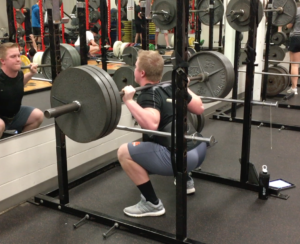
When it comes to squat philosophy, mine is fairly simple – a squat movement is included in every single workout. If we are doing a 3-day lifting program, we are squatting 3 days. If we are on a 4-day program, we are squatting 4 days. The squat, in my opinion, is the most functional lift for athletes. Because of its importance, it should be practiced and performed on a regular basis. Just like any sports skill, the more time an athlete spends working on it, the better and more proficient they will become at doing it. The squat is no different. Daily repetition performing a proper squatting movement will pay huge dividends in the long run.
Benefits of the Squat for Athletes:
- It’s ground-based. Athletes perform and compete with their feet on the ground. They run, jump, and change direction by exerting force against the ground. Squats do the same time – exert force against the ground into order to move the weight.
- It’s a multi-joint movement. Movement when squatting, occurs in the hip joints, knee joints, and ankle joints at the same time. This not only means that all on the major muscle groups of the lower body are being training in one exercise, but they are being trained together in a synchronous manner similar to how they are used while an athlete is competing in their sport.
- Squats help to strength the core. Putting a heavy weight on your back, or front, or holding overhead and then moving with it requires great stability of the core while performing the movement.
- Squats can help to improve flexibility and mobility when moving through a full range of motion.
Because of the multiple days each week with squats, we manipulate the training variables daily, including the types of squats used. The types of squats that we utilize regularly are the following:

- Primary Squats:
- Back Squat
- Front Squat
- Sport Back Squat (narrow stance, feet parallel to each other)
- Secondary Squats:
- Goblet Squats
- Overhead Squats
Each workout will usually incorporate one of the three primary squats, and we will typically rotate between those three from one workout to the next. The secondary squats, on occasion, will be used in place of one of the primary squats. Most of the time though, they are used as a second squat movement and as an auxiliary lift on some days. From a programming standpoint, the volume and intensity will also change on a daily basis.
3-Day Workout Program
| Monday: | Wednesday: | Friday: | |
|---|---|---|---|
| Intensity: | Medium | High | Low |
| Volume: | Medium | Low | High |
4-Day Program Options
Option 1 (Typical):
| Monday: | Tuesday: | Thursday: | Friday: | |
|---|---|---|---|---|
| Intensity: | Medium | High | Medium | Low |
| Volume: | Medium | Low | Medium | High |
Option #2 (2 Heavy Days):
| Monday: | Tuesday: | Thursday: | Friday: | |
|---|---|---|---|---|
| Intensity: | Medium | High | High | Low |
| Volume: | Medium | Low | Low | High |
Option #3 (2 Medium Days, Heavy on Thursday after the rest day):
| Monday: | Tuesday: | Thursday: | Friday: | |
|---|---|---|---|---|
| Intensity: | Medium | Medium | High | Low |
| Volume: | Medium | Medium | Low | High |
Changing these variables (squat type, intensity, volume) on a daily basis is extremely important. It’s is critical in order to keep your athletes fresh, and to prevent plateauing or even worse – over-training. Traditional training theory typically follows the thought that there needs to be 1-2 days of recovery following a lifting workout. The human body though is pretty amazing and very resilient. As the SAID principle states, the body will adapt to the stress that is placed upon it. And as I have found, with squats, it adapts very, very quickly. If programmed correctly and monitoring your athletes, including a squat in every workout can definitely be done and will take your athletes’ squats to the next level.




